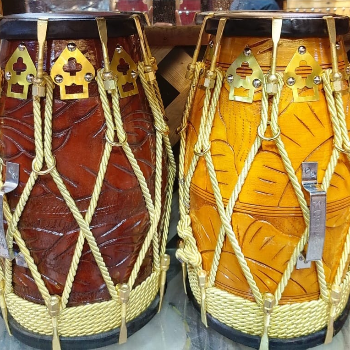In the vibrant heart of Pune, where traditional melodies echo through bustling streets and cultural heritage is celebrated with unmatched enthusiasm, lives Rajesh Kumar, a man driven by a passion to keep his family united. Rajesh, like many Indians, cherishes the irreplaceable bond of family gatherings. However, over the years, he had begun to notice a growing divide within his family caused by the distractions of modern technology. Children glued to their screens, and adults busy with their smartphones, had turned their once lively family gatherings into mere formalities.
Rajesh yearned for the laughter, stories, and music that once filled their living room. He wanted to bring back the connection between generations that seemed to be slipping away. It was during a casual conversation with his friend Priya that he stumbled upon a potential solution—introducing a dholak to their gatherings.
A dholak, with its deep-rooted significance in Indian culture, is more than just a musical instrument. It is a conduit for stories, a medium for expression, and a tool for unity. Rajesh was fascinated by the idea. He remembered his grandfather’s tales of village festivals where a dholak was pivotal in bringing people together, evoking joy and camaraderie.
Determined to revive this tradition, Rajesh purchased a beautifully crafted dholak. His first step was to learn the basics of playing it. With the help of online tutorials and some guidance from local musicians, Rajesh soon became proficient enough to lead a small family jam session.
The first gathering with the dholak was nothing short of magical. As Rajesh began to play, the rhythmic beats resonated through the room, drawing curious eyes away from their screens. His children, initially hesitant, began clapping along. Inspired by the infectious energy, his elderly father joined in with a traditional folk song, his voice rich with nostalgia.
The dholak became the heart of their gatherings, transforming them into vibrant, participative events. The children discovered a newfound appreciation for their cultural roots, learning songs and stories from their grandparents. Even Rajesh's teenage daughter, Meera, who was usually engrossed in her smartphone, started showing interest in learning to play the dholak. This shared activity bridged the generational gap, creating a common ground for the entire family.
Rajesh’s story is a testament to the emotional problem that the dholak solves—disconnection in an era of digital dominance. While technology offers countless benefits, it can sometimes alienate individuals within a family. The dholak, with its ability to engage everyone regardless of age, rekindles family bonds, fostering an environment of togetherness and joy.
Moreover, the dholak serves a practical purpose as well. It is an excellent way to introduce children to music, enhancing their cognitive skills and cultural awareness. It offers a sense of accomplishment and joy, nurturing their creativity and emotional intelligence.
In the broader context of preserving cultural heritage, the dholak plays a crucial role. It is a reminder of our roots, a bridge that connects us to our past while enriching our present. For families like Rajesh’s, it is not just an instrument but a catalyst for connection, continuity, and celebration.
In essence, the dholak is the heartbeat of Indian gatherings, a timeless tradition that brings people together through the universal language of music. It is a symbol of unity, a beacon of cultural pride, and a reminder of the power of shared experiences.
For Rajesh, the dholak has become an integral part of his family’s story, a beloved tradition that he hopes to pass on to future generations. His journey from disconnection to unity illustrates the profound impact a simple instrument can have on family dynamics and cultural preservation.
If you find yourself yearning for a deeper connection within your family, consider the dholak—not just as an instrument, but as a meaningful addition to your home. Let its rhythm guide you back to the heart of what truly matters—togetherness.
This blog post captures Rajesh’s journey, highlighting the emotional and practical benefits of incorporating a dholak into family gatherings. By sharing this compelling story, readers are encouraged to consider how the dholak can enhance their own family dynamics, preserving cultural heritage and fostering unity in a modern world.
Visit Vyaparify Site:
https://id.vyaparify.com/sarlas-musicals 
